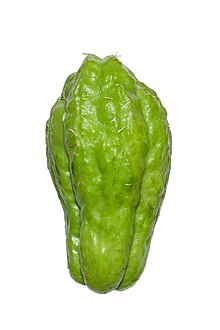
Back شايوت Arabic شايوت ARZ Sechium edule AST Waluh Jepang BAN Sayotes BCL Чаёт ядомы Byelorussian Чайот Bulgarian Susut Bislama Chouchou Breton Xaiota Catalan
| Chayote | |
|---|---|

| |
| Chayote fruit | |

| |
| Chayote fruit cut lengthwise | |
| Scientific classification | |
| Kingdom: | Plantae |
| Clade: | Tracheophytes |
| Clade: | Angiosperms |
| Clade: | Eudicots |
| Clade: | Rosids |
| Order: | Cucurbitales |
| Family: | Cucurbitaceae |
| Genus: | Sicyos |
| Species: | S. edulis
|
| Binomial name | |
| Sicyos edulis | |
| Synonyms[1] | |
| Nutritional value per 100 g (3.5 oz) | |
|---|---|
| Energy | 80 kJ (19 kcal) |
4.51 g | |
| Sugars | 1.66 g |
| Dietary fiber | 1.7 g |
0.13 g | |
0.82 g | |
| Vitamins | Quantity %DV† |
| Thiamine (B1) | 2% 0.025 mg |
| Riboflavin (B2) | 2% 0.029 mg |
| Niacin (B3) | 3% 0.47 mg |
| Pantothenic acid (B5) | 5% 0.249 mg |
| Vitamin B6 | 4% 0.076 mg |
| Folate (B9) | 23% 93 μg |
| Vitamin C | 9% 7.7 mg |
| Vitamin E | 1% 0.12 mg |
| Vitamin K | 3% 4.1 μg |
| Minerals | Quantity %DV† |
| Calcium | 1% 17 mg |
| Iron | 2% 0.34 mg |
| Magnesium | 3% 12 mg |
| Phosphorus | 1% 18 mg |
| Potassium | 4% 125 mg |
| Zinc | 7% 0.74 mg |
| †Percentages estimated using US recommendations for adults,[2] except for potassium, which is estimated based on expert recommendation from the National Academies.[3] | |
Chayote or Sicyos edulis (previously placed in the obsolete genus Sechium), also known as christophine, mirliton and choko, is an edible plant belonging to the gourd family, Cucurbitaceae. This fruit was first cultivated in Mesoamerica between southern Mexico and Honduras, with the most genetic diversity available in both Mexico and Guatemala.[4] It is one of several foods introduced to the Old World during the Columbian Exchange. At that time, the plant spread to other parts of the Americas, ultimately causing it to be integrated into the cuisine of many Latin American nations.
The chayote fruit is mostly used cooked. When cooked, chayote is usually handled like summer squash; it is generally lightly cooked to retain the crispy consistency. Raw chayote may be added to salads or salsas, most often marinated with lemon or lime juice, but is often regarded as unpalatable and tough in texture. Whether raw or cooked, chayote is a good source of Vitamin C.
Although most people are familiar only with the fruit as being edible, the root, stem, seeds and leaves are edible as well. The tubers of the plant are eaten like potatoes and other root vegetables, while the shoots and leaves are often consumed in salads and stir fries, especially in Asia.
- ^ POWO: Sicyos edulis Jacq. (retrieved 11 March 2024)
- ^ United States Food and Drug Administration (2024). "Daily Value on the Nutrition and Supplement Facts Labels". FDA. Archived from the original on 2024-03-27. Retrieved 2024-03-28.
- ^ National Academies of Sciences, Engineering, and Medicine; Health and Medicine Division; Food and Nutrition Board; Committee to Review the Dietary Reference Intakes for Sodium and Potassium (2019). Oria, Maria; Harrison, Meghan; Stallings, Virginia A. (eds.). Dietary Reference Intakes for Sodium and Potassium. The National Academies Collection: Reports funded by National Institutes of Health. Washington, DC: National Academies Press (US). ISBN 978-0-309-48834-1. PMID 30844154. Archived from the original on 2024-05-09. Retrieved 2024-06-21.
- ^ León, Jorge (2000). Botanica de los cultivos tropicales (in Spanish). Agroamerica. pp. 166–168. ISBN 978-92-9039-395-5.
© MMXXIII Rich X Search. We shall prevail. All rights reserved. Rich X Search